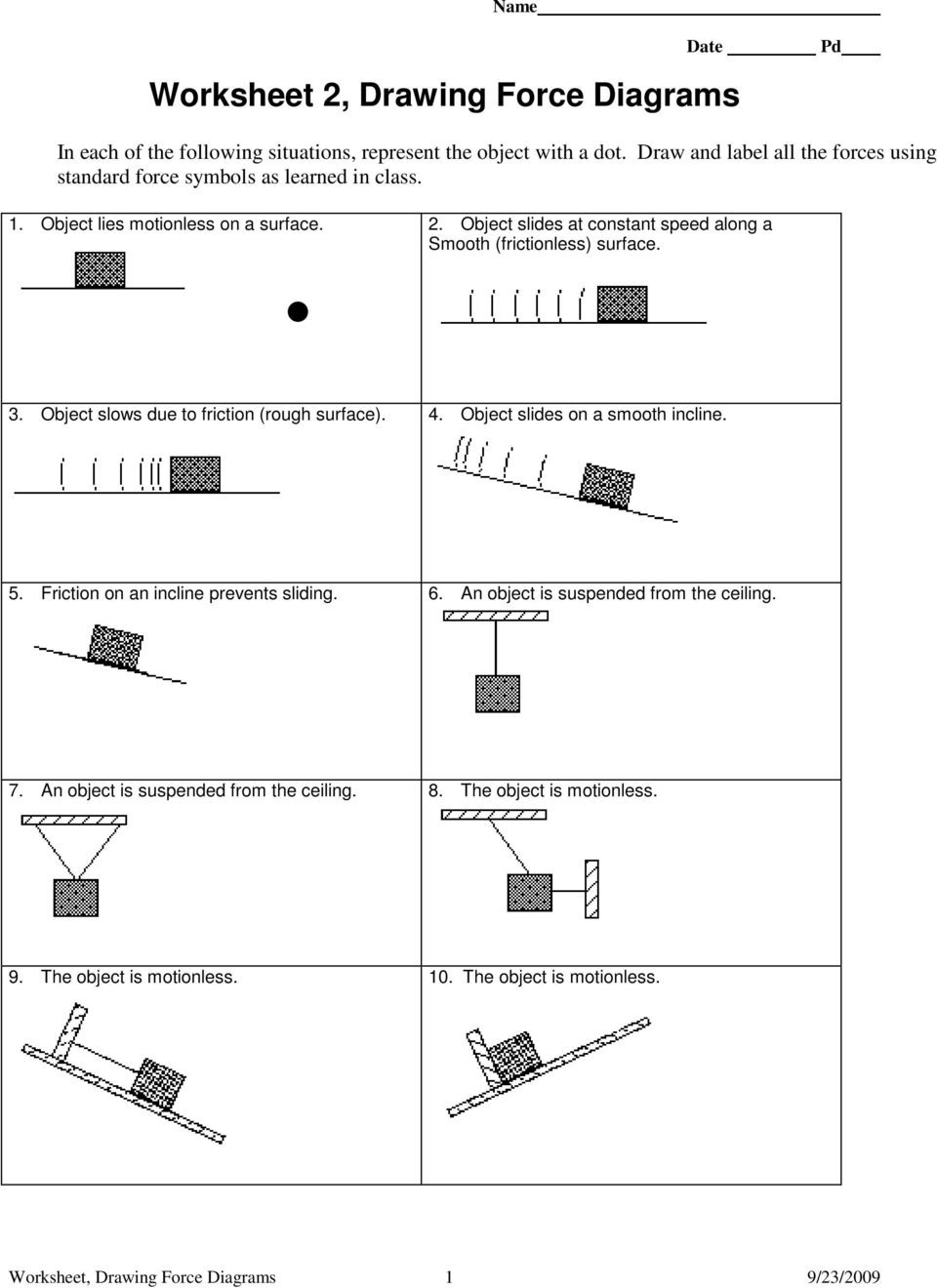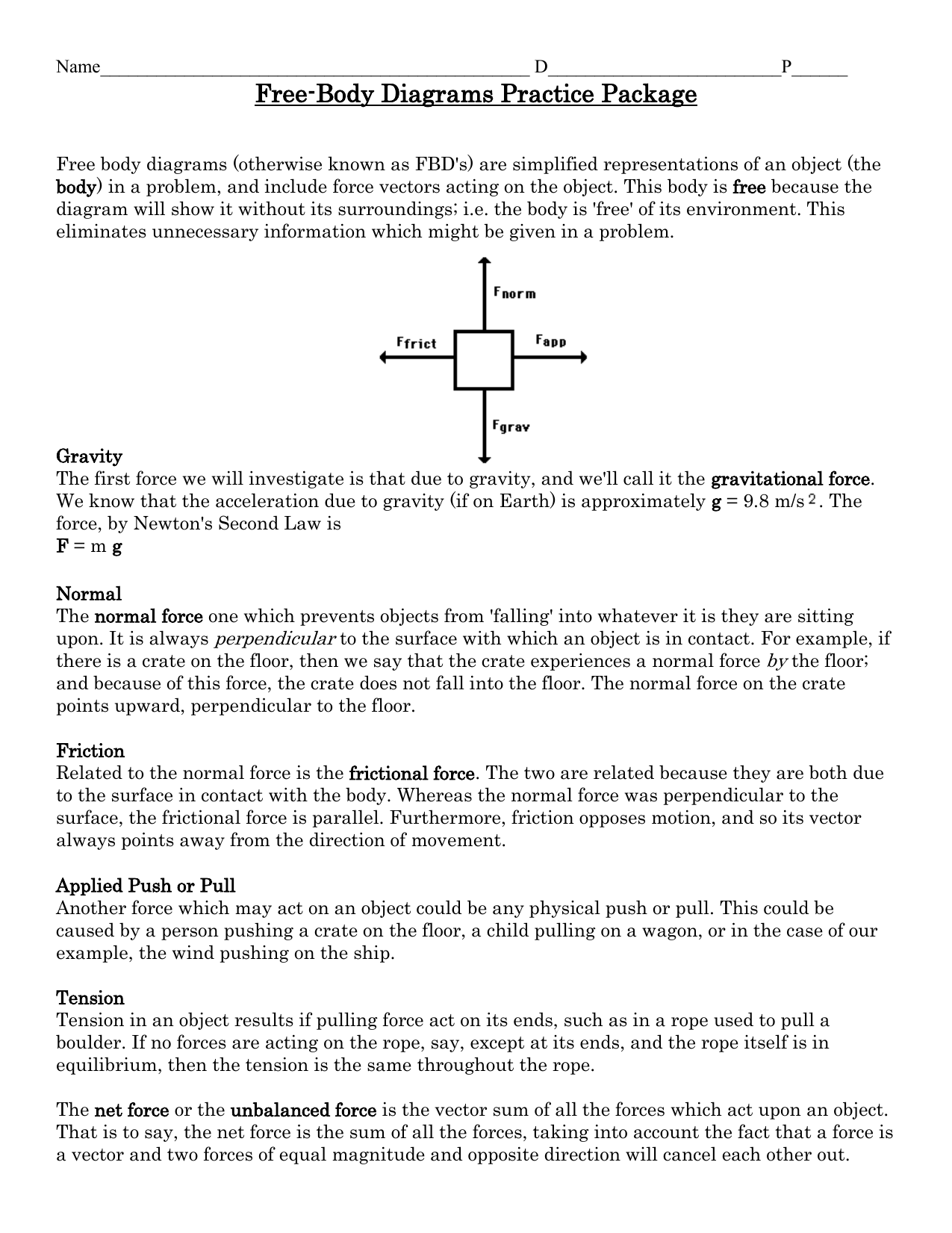
Secondly, the Earth is not a perfect sphere but rather an oblate spheroid that bulges at the equator so that the equatorial radius is 6378 km but the polar radius is 6357 km. This is a variation of 10% but the crust only comprises about 1.6% of the Earth’s mass since the density of material in the mantle and core is far higher so the variation in g due this factor is probably of the order of 0.2%. The density of the rocks comprising the Earth’s crust varies between 2.6 – 2.9 g/cm 3 (according to Jones 2007). The Earth is not of uniform density and volumes of rock within the crust of especially high or low density could affect g at the surface. There are three factors which can affect the local value of g.įirstly, the distribution of mass within the volume of the Earth. (2013) the lowest value for g on the Earth’s surface is atop Mount Huascarán in Peru where g = 9.7639 m s -2 and the highest is at the surface of the Arctic Ocean where g = 9.8337 m s -2.
DRAWING FREE BODY DIAGRAMS ANSWERS FREE
It is 9.81 metres per second per second in the United Kingdom, yes but the value of both acceleration due to free fall and the gravitational field strength vary from place to place across the globe (and in the SI System of measurement, the two quantities are numerically equal and dimensionally equivalent).įor example, according to Hirt et al.

That an object in free fall will accelerate towards the centre of our terraqueous globe at a rate of 9.81 metres per second per second is, at best, only a partial and parochial truth. Samuel Johnson, The Rambler, 17 April 1750 setting storms and billows at defiance, and visiting the remotest parts of the terraqueous globe. The Gnome Experiment Kit from precision scale manufacturers Kern and Sohn. Using resolving a vector into components to solve problems We have resolved the 13 metre distance into two components: one eastward (horizontal) component of 12 metres and one northward component of 5 metres. (Don’t believe me? Count the squares on the diagram!) By moving from O to P we change our longitude by 12 metres and our latitude by 5 metres. To rewrite Robert Frost: We took the two roads less travelled by / And that has made NO difference.īut why should we wish to go the ‘long way around’, even if we still end up at P? Because it would allow us to work out the change in longitude and latitude. So walking one road less travelled might, indeed, make ‘all the difference’ - but walking two roads less travelled does not. And then we look around, and strike out northwards and walk the (vertical) ‘road less travelled called XP - and we end up at P.

We did not walk along that road - and that’s why it is drawn as a dotted line - but we could have done.īut let’s say that we had, and that we had stopped when we reached the point marked X. It is drawn as a dotted line because it is (literally) the ‘road less travelled’. The dotted line OX is the eastward (horizontal on our diagram) component of the displacement OP. This could be drawn as a scale diagram as shown below.Ĭould we analyse the displacement OP in terms of an eastward displacement and a northward displacement? Let’s say we travelled a distance of 13 m from point O to point P on a compass bearing of 067 degrees (bear with me, I’m working with a slightly less familiar Pythagorean 3:4:5 triple here). Introducing components as ‘the vector less travelled by’ Two roads diverged in a wood, and I.

Because of this, they cannot affect each other’s magnitude and direction and so can be dealt with separately and independently that is to say, we can choose to consider what effect the vertical component will have on its own without having to worry about what effect the horizontal component will have. The component vectors are chosen so that they are mutually perpendicular. What is a component vector?Ī component vector is one of at least two vectors that will combine to give one single original vector. We’re going to use scale drawing rather than trigonometry since (a) this often leads to a more secure understanding and (b) it is the expected method in the UK curriculum for 14-16 year olds. In this part, we’re going to look at the inverse operation: splitting a single vector into two component vectors. In part 1 we looked at the idea of combining two vectors into one that is to say, finding the resultant vector. This post suggests some strategies for teaching vectors to 14-16 olds.


 0 kommentar(er)
0 kommentar(er)
